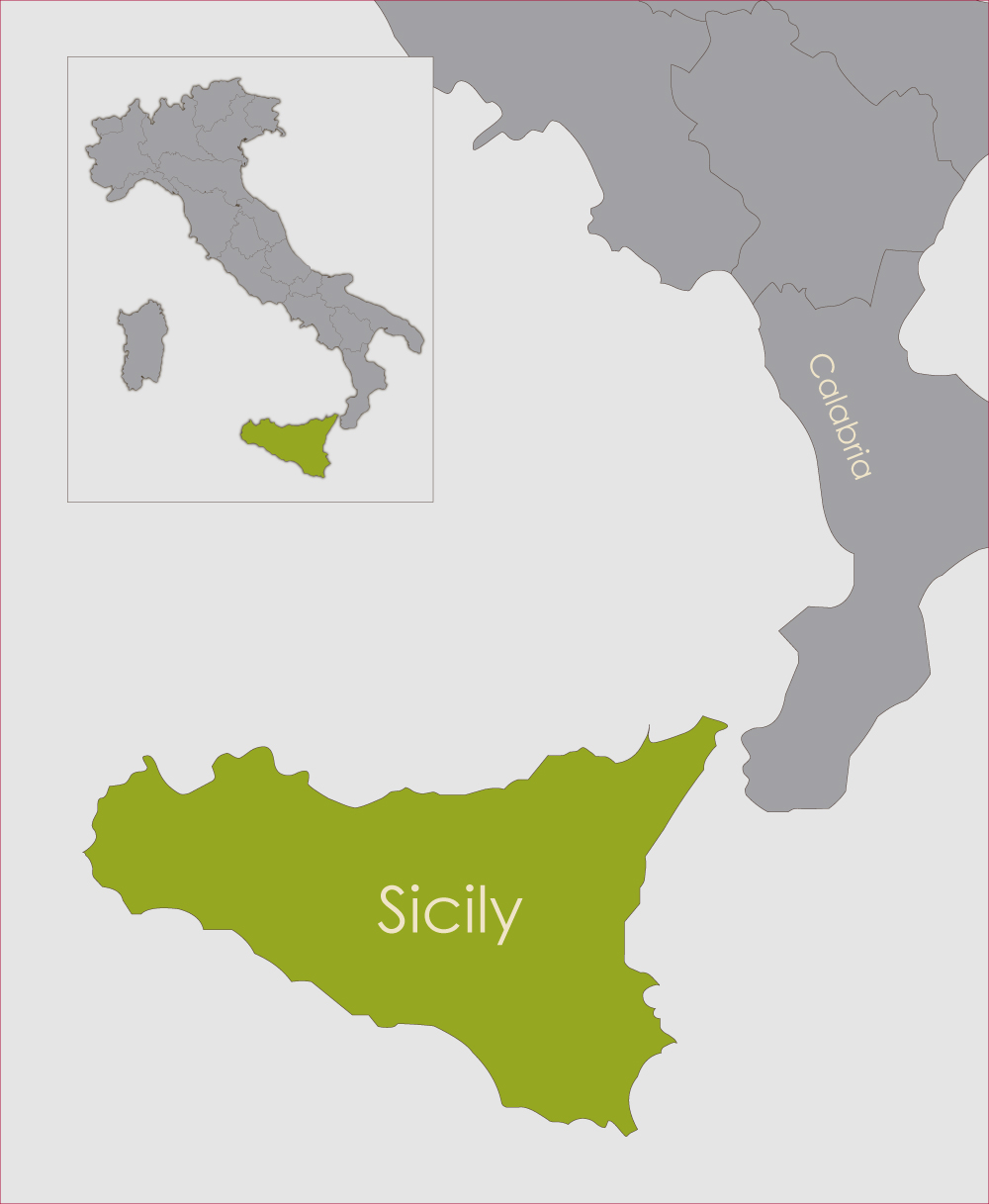 |
FAST FACTS
PRODUCERS TENUTA CAPOFARO, TENUTA TASCANTE, TENUTA WHITAKER, SALLIER DE LA TOUR, LIMÒNIO |
OVERVIEW
Sicily is the largest island in the Mediterranean Sea. This island, along with numerous smaller islets surrounding it, forms one of the 20 Italian regions. Both the region and its main island are known as Sicilia (pronounced see-CHEEL-ya) in Italian. Sicily has long been one of Italy’s most important sources of wine. Thanks to its benevolent climate, Sicily has a relatively easy time growing grapes, and economics dictated that quantity would prevail over quality for most of history. However, in the past few decades, regulatory and market conditions have changed in such a way that quality wine production in Sicily has become cost-effective, and the island’s wine output has dropped in volume while rising sharply in quality. The future looks even brighter.
History: The early history of Sicily is mind-bogglingly complex, with a constant parade of new peoples and powers coming and going. Several prehistoric groups were present when the Phoenicians arrived around the 8th century BC. Thereafter, there was settlement or occupation by Greeks, Carthaginians, Romans, Vandals, Ostrogoths, Byzantines, Arabs, and Normans over the next 2,000 years.
After successfully driving out the Arab rulers in the late 11th century, the Normans created a Kingdom of Sicily that eventually included not only the island but also the southern half of the Italian Peninsula. At a bleak time in European history, the kingdom was among the richest and most civilized in Europe, in large measure due to the groundwork laid by the Arabs. The kingdom reached a high point in the early 13th century after the Norman monarchy died out and was succeeded by Holy Roman Emperor Frederick II, of a German dynasty but Italian by birth and choice.
After Frederick, the crown of Sicily passed to the Count of Anjou, but the Sicilians were not at all happy with their French overlords, and they rebelled in 1282. Following several years of fighting, the Kingdom of Sicily broke in two. Sicily pledged loyalty to the King of Aragon (Spain), while the rest of the kingdom in the southern Italian Peninsula remained more or less under French rule. Yet such was the allure of Sicily that both halves of the former entity continued to call themselves the Kingdom of Sicily.
Over the centuries, the monarchs based in Palermo (Sicily) and those in Naples were members of various European dynasties, and once in a while the same person sat on both thrones. At the turn of the 19th century, Sicily (along with Sardinia) was one of the only parts of Italy that was able to avoid domination by Napoleon’s forces. After Napoleon’s defeat, Sicily and southern Italy were again united, as the Kingdom of the Two Sicilies, which lasted until Giuseppe Garibaldi brought it into the Kingdom of Italy in 1860.
Geography: Sicily is a triangular island just off the tip of Calabria. It holds a commanding position in the middle of the Mediterranean, astride one of the natural chokepoints of the sea between Italy and North Africa. The western tip of Sicily lies less than 90 miles (145 km) from the Cape Bon Peninsula in Tunisia, while the Strait of Messina between Sicily and Calabria is just 2 miles (3 km) wide. The island is quilted with rugged hills and valleys from end to end, but its most impressive topographical feature is 11,000-foot (3,330 m) Mount Etna. This active volcano, the highest peak in Italy south of the Alps, looms over the northeast of Sicily.
The region of Sicily comprises not only the main island of Sicily but also numerous small, mostly volcanic islands in the surrounding waters. To the north, the Aeolian Islands, also known as the Lipari Islands, are dotted across the Tyrrhenian Sea. This group includes the active volcanoes Vulcano and Stromboli, as well as the wine-producing island of Salina. Also of enological note is Pantelleria, the largest of Sicily’s minor islands, to the southwest halfway between Sicily proper and Tunisia.
The capital and largest city of Sicily is Palermo on the western end of the north coast. The other major city is Catania, at the foot of Mount Etna on the east coast.
Climate: Sitting in the middle of the Mediterranean Sea, what other climate could Sicily have than Mediterranean? This climate is characterized by long, hot, dry, sunny summers and mild, rainy winters. In the interior, the hills are cooler than the valleys in the summer. Periodically, sirocco winds blow north from Africa, raising temperatures and covering everything with fine Sahara dust. The main exception to the overall climate is Mount Etna, whose peak is snow-covered for half the year. The lower slopes of Etna are prized for cool temperatures and bright sun during the growing season. On Sicily’s minor islands, winds are a constant, requiring low vine training to avoid damage.
Primary grape varieties: As a crossroads and somewhat isolated part of Italy, Sicily has developed a long menu of grape varieties, both imported and indigenous. The most planted variety is Catarratto, a grape used primarily for Marsala—Sicily’s most important wine historically, but one that has become far less significant today. Following the decline of Marsala, Catarratto is rapidly being replaced with other varieties or simply ripped up.
Sicily has decided to focus its future reputation on two indigenous grapes: the red Nero d’Avola and the white Grillo. These varieties are seen as having the potential to produce high-quality wines throughout the region. Nerello Mascalese is another standout red variety, but it is confined mainly to the slopes of Mount Etna. Other indigenous grape varieties of note in Sicily include the red Frappato and the whites Ansonica, Carricante, Grecanico Dorato, and—primarily for sweet wines—Zibibbo. International varieties are of secondary importance in Sicily, led by grapes that are suited for warmer climates such as Syrah, Cabernet Sauvignon, and Chardonnay.
Key wine regions: The principal denomination of Sicily is the region-wide Sicilia DOC, which is among the top 10 in Italy in production. It, however, is greatly overshadowed by the corresponding IGP that covers the entire region, Terre Siciliane, which is first or second of all the Italian quality wine areas in production volume. There are several smaller, more specific denominations, but few are household names.
One Sicilian wine with wide name recognition is Marsala. Many people, however, associate Marsala with “cooking wine” found on grocery shelves or perhaps a non-Italian jug wine. True Marsala, by contrast, is a fortified sweet dessert wine that was world famous and in great demand in the 19th century, when dry wines didn’t travel very well. Marsala DOC, an area on the west end of Sicily, continues to produce these wines, but like all dessert wines, their market share has fallen as consumers have increasingly turned toward dry wines.
The most sought-after wines of Sicily today are those from Etna DOC, a denomination at the base of the Etna volcano. Its red wines made from Nerello Mascalese and white wines made from Carricante are considered some of the island’s best. Sicily has one wine at the DOCG level, Cerasuolo di Vittoria, a Nero d’Avola–Frappato blend from the south coast. Also noteworthy are some of the traditional dried-grape dessert wines that are a particular specialty of the minor islands. Examples include Zibibbo-based wines from Pantelleria and Malvasia-based wines from Salina in the Aeolian Islands.
Cuisine: The foods of Sicily are a mix of ingredients and styles from the various cultures that controlled the island over the centuries. For example, olive trees are thought to have been brought to Sicily by the Greeks. Rice first arrived in Europe with the Arab conquest of Sicily, and that legacy is seen in arancini, fried balls of rice, cheese, and often meat.
Ingredients commonly found in Sicilian cuisine include olive oil, capers, lemons, tomatoes, and eggplant and other vegetables. Oregano, rosemary, saffron, basil, and other herbs are plentiful as flavorings, along with sea salt.
Pasta is normally a lunchtime dish in Sicily rather than a dinner. Pasta dishes are frequently built around eggplant or seafood (sardines, anchovies, or shellfish). Baked pasta and ravioli are likely to incorporate ricotta cheese. Other typical dishes include focaccia flatbreads, and meatballs served as a main course without pasta. In general, fish and other seafood are more prevalent than meat. All sorts of seafood are served, from mussels and scallops, to squid and shrimp, to deep-sea fish such as tuna and swordfish.
The Sicilian desserts best known outside of Italy are probably cannoli, fried-dough tubes filled with sweetened ricotta. Cassata cake is a regional classic traditionally served at Easter, made with sweetened ricotta and shortbread, covered with a hard icing of almond flour and sugar and candied fruits. Another perennial favorite is granita, a frozen dessert similar to sorbet.

